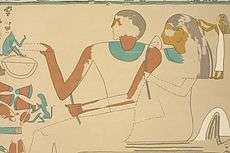Sobeknakht II
| Sobeknakht II Governor of El-Kab | |
|---|---|
|
Sobeknakht II and his wife on a painting from his tomb. Drawing by J.J. Tylor | |
| Predecessor | Sobeknakht I |
| Dynasty | 16th or 17th Dynasty |
| Father | Sobeknakht I |
| Burial | El-Kab, tomb T10 |
Sobeknakht II was an ancient Egyptian local Governor at El-Kab and a supporter of the Theban 16th or 17th Dynasty during the Second Intermediate Period.
Biography
Not much is known about Sobeknakht's life. He was the son of Sobeknakht I as well as his successor as governor of El-Kab. His father obtained this charge from a relative called Kebsi who sold it in order to settle his personal debts. This trade is documented by the Cairo Juridical stela, which was issued in Year 1 of the Theban pharaoh Nebiryraw I specifically for that purpose.[1]
Sobeknakht II was buried in the Tomb T10 at El-Kab, which is one of the most richly decorated tombs of the Egyptian Second Intermediate Period.[2] In 2003 his tomb was cleaned by British Egyptologists and was found to contain an inscription with important historical significance. It records a massive Nubian invasion on the small and fragile 16th or 17th Dynasty city state of Thebes, which was decisively repulsed by a counterattack led by this now aged Governor. It also emphasizes Sobeknakht II's important role in protecting the Theban dynasty from being destroyed during this tumultuous period.[3][4]
Datation
In addition to reporting the trade of the governorship of El-Kab from Kebsi to Sobeknakht I (father of Sobeknakht II), the aforementioned Cairo Juridical stela contains an important genealogical charter which states that Kebsi inherited the title of governor from his father Ayameru when the latter in turn inherited the vizierate from his father Aya.[1] Now, Ayameru was appointed governor of El-Kab in Year 1 of the 13th Dynasty king Merhotepre Ini. This means that a period of only 2 family generations or about 40-60 years at most separate Year 1 of the 13th Dynasty king Merhotepre Ini from Year 1 of the Theban king Nebiryraw I, who is assigned a reign of 26 years in the Turin Canon.[1]
References
Further reading
- Joseph John Tylor (1896), Wall drawings and monuments of El Kab. The tomb of Sebeknekht.
